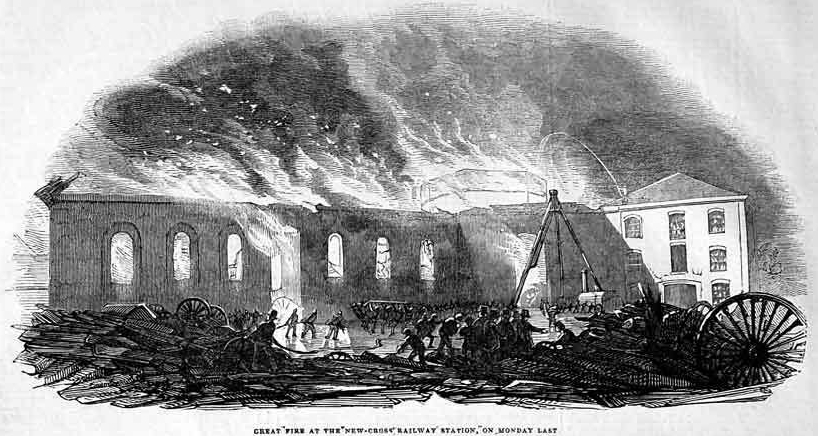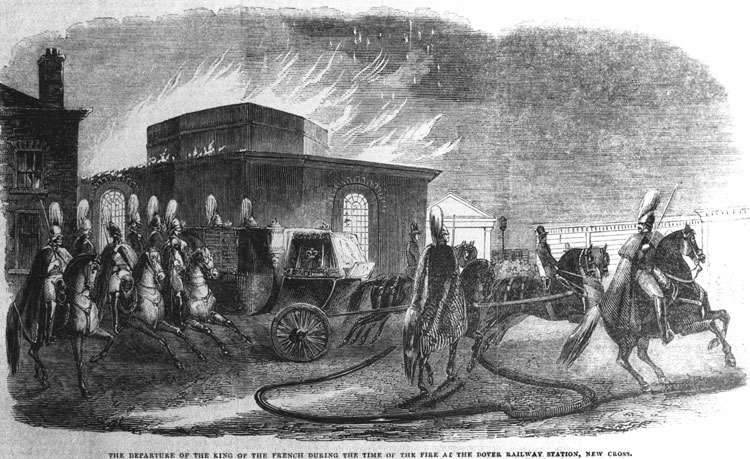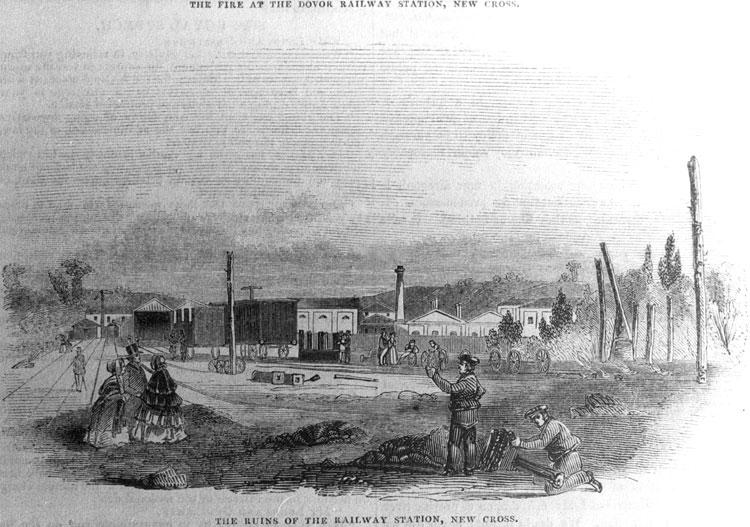
1844
A NEAR HEAD ON COLLISION 1844
Extracted & adapted from the Railway Magazine October 1955
An indent occurred in 1844, which reveals the laxity that was then all to prevalent in the Brighton railway working. On the evening in question a special boat train left Kingston station at 9 p.m. with passengers for Brighton and at the same time the usual passenger train left Brighton for Shoreham. By some mismanagement, both trains were sent off on the same line and met head-on between Hove and Southwick. Fortunately the drivers saw each other in time and shut off steam, and at the same time signalled to their guards to apply their brakes, so that a collision was just averted. Both engines were carrying red lamps in front, which seem to have given adequate warning to their approach.
Rowland Hill a early chairman of the L.B.S.C.R. introduced the policies was the enforcement of penalties on every breach of a rule. Another of his innovations was the introductions of excursion trains.
Danger Signal by means of Gunpowder 1844
The Birth of the Detonator
Major-General Pasley recommending that a Circular Letter should be sent to Railway
Companies, suggesting the adoption of a new “Danger Signal” by means of Gunpowder.
Railway Department
Board of Trade, Whitehall,
18th April,1844.
My Lords,
Two fatal accidents, which it was my duty to inquire into, having occurred within the space of thirteen months, in both of which one railway train, detained beyond its proper time, was run into by another train, causing the death of a passenger in one case, and of an engine-man in the other, notwithstanding that the usual precaution had been taken of sending a man back
from the train that was delayed with a red lantern as a signal of danger, to meet and stop the
approaching train, not only by this signal, but also by calling out to the engine-man. In both
cases this precaution proved in effectual, as the men sent back were neither heard, nor were
their red lanterns seen by the engine men of the approaching trains. In fact, I have myself
observed, more than once, that it is impossible for the engine-man or fireman of a railway
train in motion to hear a person calling to him, even from a very short distance, especially
when the train is passing under a tunnel, which causes a louder rattling noise than in the open air.
I therefore beg leave to bring under your Lordships’ notice a very ingenious arrangement
adopted on the London and Birmingham Railway, as a fog or danger signal, at the suggestion of Mr. Cowper, son of the King’s College professor of that name. This consists in sending a man back to place a small flat circular tin box containing a charge of gunpowder, mixed with a little fulminating powder, on the line of rails by which the next train is advancing; which box has two leaden fangs attached to it for clasping the rail, which at other times are doubled flat down upon the box to save room. As soon as the wheel of the locomotive engine of the approaching train passes over this box, it fires the charge, with an explosion sufficiently loud to be heard in the most stormy night, or in going through a tunnel; but not powerful enough to injure the rails or the wheels of the engine. Under the circumstances supposed, this arrangement as a signal of danger or caution, is preferable to a red light by night, or in a tunnel, because no neglect or in attention on the part of the engineman or fireman of the coming train can render it possible for them to pass without being aware of the explosion, which cannot fail to take place, and on hearing which, it would be their duty to stop. The best way of proceeding would be for the man sent back to carry a red light also, and after placing his explosion-signal-box on the rail, to return part of the way from whence he came, and remain there with his red light to meet the train on stopping, and to explain to the engineman whatever may be necessary.
I shall conclude by observing, that I am fully persuaded that the more perfect system of
danger-signal just . if generally adopted on railways, may be the means of saving lives
hereafter; and therefore I request, should your Lordships concur in this opinion, that you will be pleased to call the attention of the Directors of Railway Companies to the subject by a circular letter.
I have, &c.,
C. W. Pasley, Major-General, and Inspector General of Railways.
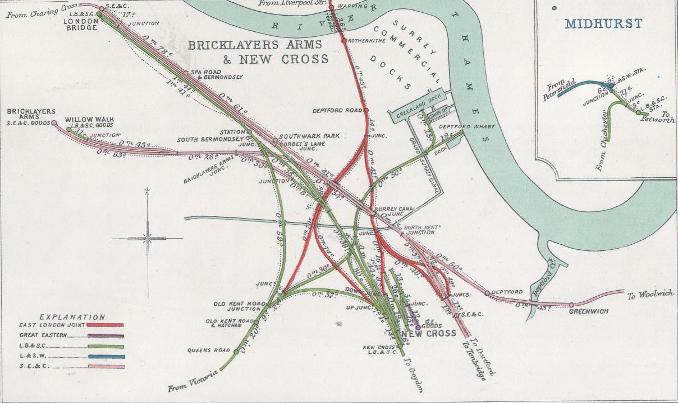
NEW CROSS - BRICKLAYERS ARMS - LONDON BRIDGE
RAILWAY LINES
1908
BRICKLAYERS ARMS TERMINUS
Bricklayers Terminus opened on the 1st May 1844 owing to the increasing congestion at
London Bridge, and dissatisfaction with the high tolls charged by the London and Greenwich Railway, caused the South Eastern Railway and the London and Croydon Railways to build a short branch line to a new terminus at Bricklayers Arms. All of the London & Croydon company's trains and half of the South Eastern trains were diverted to the new station.
With the merger of the London & Croydon and the London & Brighton Railway to form the
L.B.S.C.R. passengers service was ceased but they continued using it for goods traffic.The passenger station closed on the 1st January 1852, and remained opened as goods depot. After closure of the passenger facilities the original goods station and the surrounding site
proved to be ideal for the development of the main South Eastern Railway goods depot in
London. New sidings were laid and the former passenger station was converted into a goods
station.
The L.B.&S.C.R. inherited the L.& C.R. running powers over the branch line and established their own independent goods facilities on the contiguous site at Willow Walk in July 1849. These replaced the former L.& C.R. facilities at New Cross.
The L.B.& S.C.R. facilities were enlarged in 1854 after the Brighton company entered into an agreement with the S.E.R.’s rival, the London, Chatham and Dover Railway to handle their goods traffic at the depot. Further extensions were built in 1865 and 1902.
The Willow Walk depot was officially merged with the Bricklayers Arms depot by the
Southern Railway in March 1932. Bricklayers goods station closed in 1981.
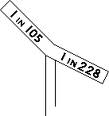
INTRODUCTION OF GRADIENT BOARDS
In June 1844 the London & Brighton Railway starting to introducing gradient boards which order by the Locomotive Committee, which were to be placed on the line side as warnings to drivers when running downhill. These were not, however, appreciated by all loco crews, since the Punishment Register for August, 1844 shows Driver Meyrick and Fireman Taylor of loco no. 58 were fined £2 2s.0d. each as a result of rekindling the fire of their engine with gradient boards and fencing.
* Depot of loco-men not known.
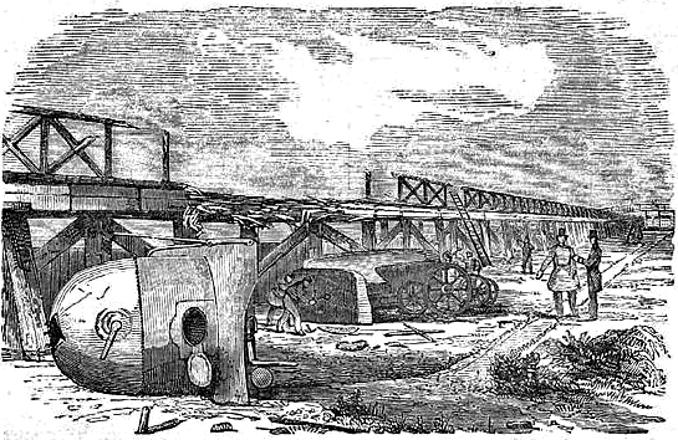
THE SCENE OF THE RAILWAY ACCIDENT NEAR NEW CROSS
Railway accidents on the
London & Croydon Railway
from http://www.railwaysarchive.co.uk
Anerley on 5th October 1844 No mention Enginemen
SEE SUB PAGE
London Bridge on 7th October 1844
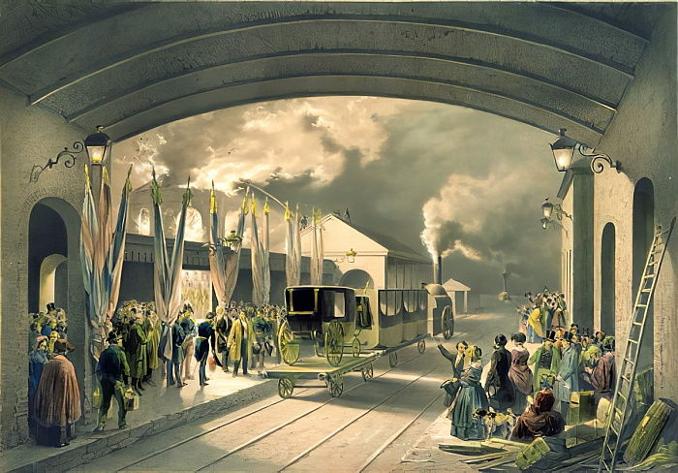
Artist Unknown
King Louis Phillippe of France being greeted at New Cross, during his visit to Windsor Castle
DESTRUCTIVE FIRE
AT NEW CROSS RAILWAY STATION
19th OCTOBER 1844
ILLUSTRATED LONDON NEWS
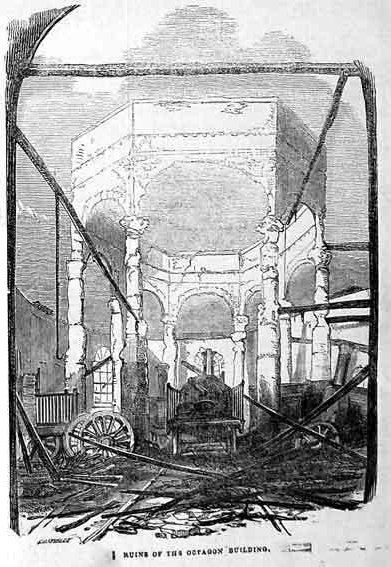
The London &New Cross Loco Shed
One of the most fearful fires that have occurred in the neighbourhood of the metropolis for many years took place at a late hour on Monday evening, at the works attached to the station of the South Eastern, Brighton, and Croydon Railways at New-cross, resulting in the destruction of property to an enormous amount.
The New-cross station is to the above railways what Wolverton is to the London and Birmingham line. It communicates with the metropolis by the Kent Road on which it is situated; and with the Thames by part of the old Croydon Canal. The area occupied by the station is about equal to that of Russel Square. it consists of an assemblage of vast workshops, large lathe and planning machine rooms, furnace rooms, carpenters’ and painters’ room, carriage and fire engine houses and a grand octagonal engine house, nearly as larges as the Colosseum in the Regent’s Park; in the centre is a stone shaft, surround by a circle of columns supporting a roof in the manner of the Chapter-house, at Salisbury; between these columns are eight large doorways with tracks for the engines and tenders. The height of this vast octagonal building is, or rather was, 70 feet; and with the range of carriage and workshops attached, it was part of the original station, its erected under the superintendence of Mr. Gibbs, the engineer to the Company; it was handsomely built of brick, with stone finishing.
The fate commenced in a loft of this large octagonal building, fitted up as a painter’s shop, upwards of eighty feet in breadth, having in its centre a lantern roof, to the extreme right of the structure, seventy feet. The works were all shut up, and the interior of the station was in a state of animation in consequence of the approaching arrival of the King of the French, he having signined his intention of proceeding to Dover by this route. There were present Captain Charleswood, super indent of the Dover Railway; Mr. Howell, deputy superintendent of the same line;Mr. Cubitt, a engineer; with several others. While the work people were engaged erecting the tent on the platform for his Majesty’s reception, they were startled by cries of “Fire.” The vogue repository was then found to be burning in the upper part, among the paint store, and the flames made such rapid progress, that in less than a quarter of an hour the whole building was in a blaze. The fire was greatly assisted by a quantity of oil and turpentine, as well as paint, that had been laid aside in a part of the engine room. The police force hastened to the spot, and were most active in maintaining order, and saving he property and books from the office adjoining the burning pile. It was near an hour before any engines arrived, and by this time the conflagration had spread to a long building, also used to keep the carriages and steam engines in. By eleven o’clock the roofs of both houses (which were boards covered with lead, and on iron rafters) fell in, and then the engines, amounting to about fourteen, were able to make an effectual resistance. The conflagration was fearfully rapid, the flames rushing up through the lantern, whence they burnt with increased fury, until the roof and fell in. Attempts were then made to save the various shops beneath, but in vain. Engines from the dockyard at Deptford, and from the London fire brigade, reached the scene before ten o’clock the fire having broken out at nine.
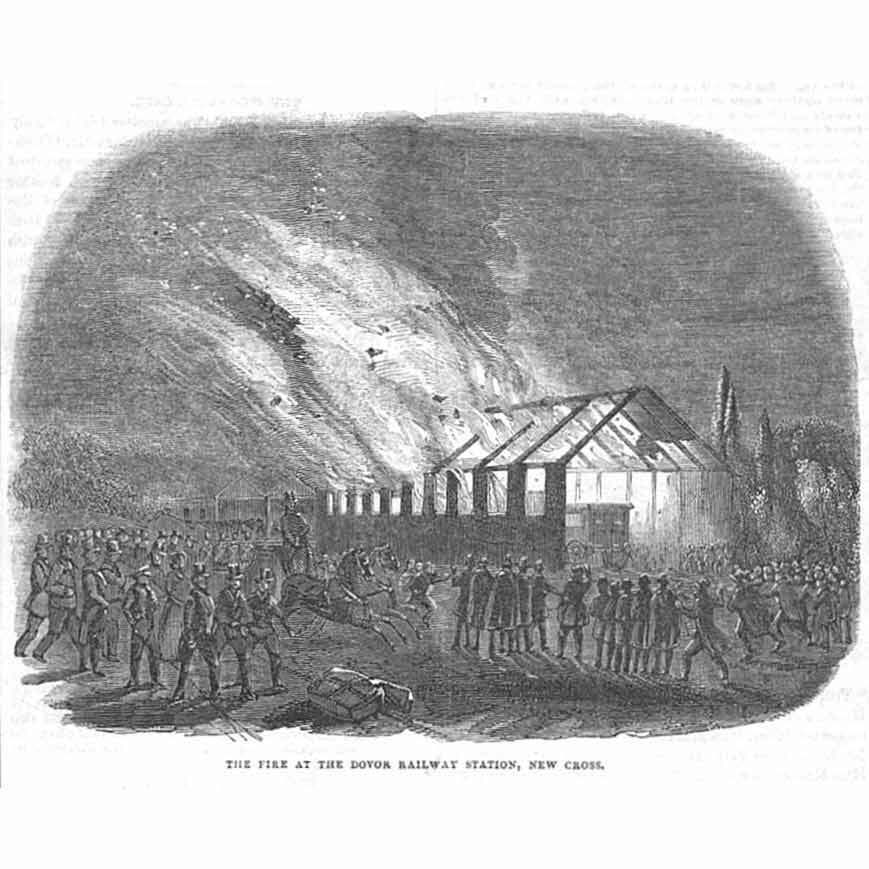
The firemen at the first appeared to be completely bewildered; the flames were rushing out of the roofs and nearly every window in the octagon and fitting departments, and were roaring sound. At the same moment, the molten lead, was running from the cornices round the blazing property, thereby exposing every one to great danger. Nevertheless every man exerted himself with the greatest intrepidity, and by that means a long range of premises used for the erection of carriages was saved. There was a spacious tank between the two building, but the fire was so fierce, that it completely reached over the tank, and almost set the roof a blaze. It was indeed truly distressing to see the valuable lathes and splendid machinery in fitting house falling a sacrifice. There was no alternative, the whole was quickly destroyed or rendered useless. For two hours and upwards the fire continued to rage with awful violence, although its progress bad, to a certain extent been stopped. The immense mass of inflammable materials that the two buildings contained with the heavy floors and roofs, caused the fire to be frightful extent, the flames risings to such a great altitude as to be seen for many miles distant attracting some thousands of persons to the spot.

His Majesty the King of the French arrived at the station at about eleven o’clock, and on alighting expressed his great regret at the calamity.
One very fortunate circumstances was that the wells from which the engine worked were powerfully charged with water the engines being supplied by steam engine on the works, and to this in a great measure may be attributed the saving of the remainder of the company’s property.
At one o’clock a great number of the engines were still in full operation, there remaining a great body of fire in the ruins. The hose of some were directing streams of water from the warehouses and adjacent buildings into the burning mass beneath, while the firemen were stationed on all sides to prevent the flames from extending. Up to this period, and an hour subsequently, several attaches of the King of the French, who were to follow in another train after the royal carriage, were to be mingled with the police and firemen. Their state dresses wonderfully contrasted with those of the fire corps, whose appeal was covered wit mud, and their faces as black as sweeps. In the course of another half hour or so the whole of the suite left the New-cross station in a special train, on their way to Dover.
The exact amount of property destroys as well as the extent of insurances, are as follows:- The octagonal building, as well as the fitting house, which was 120 feet long by 30 wide, were insured in Westminster Fire Officers for £4600, and the contents in the Phoenix Office to the amount £9000, making a total of £13600. There were in the octagon six engines and three tenders, the former valued at £1300 each, and the latter at £200 each. It will cost an enormous more to replace the machinery alone. The company estimate the damage under £20,000.
The cause of the fire had been traced to the spontaneous ignition of some vegetable black which was stowed in the paint room.
The ruins, particularly those left of the octagonal or principal buildings, as the fire gradually subsided, had a most remarkable appearance. The upright walls of the upper story, or lantern, which was supported by four stone pillars, while the body of fire was raging beneath, was so charred and splinter by the intensity of the heat, that they resembled the fretted pillars of some ancient monastery, which had been worn away by the lapse of years, while the wreck of several locomotives was to be seen along the extensive line of shedding, presenting a most serious loss of this valuable property of the company.

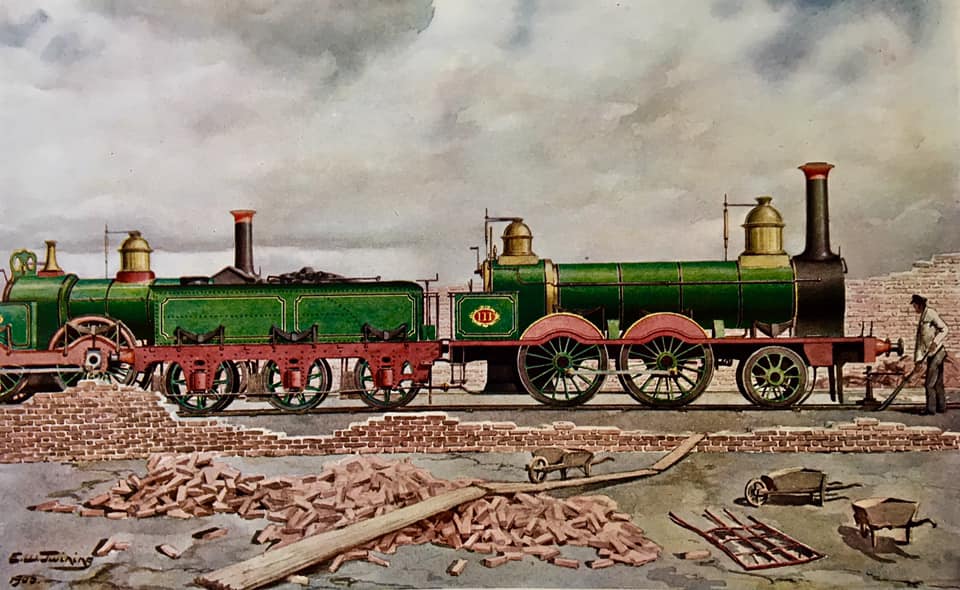
ARTIST ERNEST W TWINING
Engine No.111 at New Cross Loco Shed after the fire
FATAL ACCIDENT ON
THE LONDON AND BRIGHTON
RAILWAY
INVOLVING DRIVER ROBERT WHALEY AND HIS FIREMAN JOHN WRIGHT
The report below was published in
the Sussex Advertiser on Tuesday 5th November 1844
An inquest was held on Tuesday last, at the Station Inn Hayward’s Heath, by Alfred Gell, Esq., Deputy Coroner, on the body of George Mitchell, a labourer, on the above railway, who met his death on Saturday, the 26th October, in the awful manner shown in the following evidence given at the inquest.
Robert Whaley, sworn-I am an engine driver on the London and Brighton Railway, and live at Croydon. I left Brighton on Saturday night at half-past 11 o’clock with the engine No. 70 of the London and Brighton Railway Company, and arrived at the place where the accident occurred a few minutes before 12. We were in the Folly Hill cutting in the parish of Keymer, proceeding at the rate of 15 miles an hour when I felt a sudden jerk of the engine; I said to the fireman that was with me, what is that, he said we had run over a man, I said that can’t be, he said he was sure of it for he saw a man’s hat fly past the engine, by this time we had stopped the engine and we went back about 30 yards but I could see nothing, my mate said here he is, and I then saw the deceased lying in the ditch which carries the water off from the line; we took him out and placed him by the side of the line, and started off to Hayward’s Heath station for assistance; we then took the body back to the Station Inn; this was about quarter past 12; It was a moonlight night and I could see a long distance before me; I am sure the man was not walking on the line or I must have seen him; my opinion is that he was lying down on the line; it was on the left hand side of the line from Brighton; the deceased was quite dead when we took him out of the ditch; we had our usual signals on the engine and the deceased must have heard us coming had he not been asleep.
John Wright sworn: I am a fireman or stoker on the London and Brighton Railway; I was with the last witness at the time of the accident, in Folly Hill cutting; I felt the engine jerk and at the same instant saw a man’s hat fly past the engine; I said we have run over a man and Whaley said, “surely not,” we stopped the engine, took the lamp and found the deceased in the ditch.”-This witness corroborated the evidence of the engine-driver in most particulars.
Thomas Spry Byass sworn: I am a surgeon and reside at Cuckfield; about twenty minutes past one, on Sunday morning, I arrived at Hayward’s Heath Station; deceased was quite dead when I got there; I found a large wound in the abdomen, the intestines protruding, which was quite sufficient to cause sudden death; It appeared as if a heavy weight had pressed upon the body; I have no doubt but that deceased was dead in an instant after the accident happened.”
George Pratt sworn: I am a labourer and I live at St. John’s common; I saw deceased at Ellis’s Beer Shop, at Burgess Hill about nine o clock on Saturday night, and we drank together, he had one pint of beer when he first came in and had one glass with me; we then went to another beer shop, the New Anchor, kept by Agate, also at Burgess Hill; we stopped there till ten o’clock, during which time we had three pints of ale between us; I walked with deceased to Cants Bridge, which crosses the Railway; I asked him if he was going home and he said yes, but he did not want to get home till mid-night as there was a warrant out against him for poaching, and he has been away from home some time. He was working on the Line between Burgess Hill and The Hassocks; the deceased’s wife and family live at Balcombe, and I last saw him walking in that direction, on the Line, about two miles from Folly Cutting.
He did not appear to be a bit worse for what he had to drink; I have known him for some years.”-
Verdict: that deceased was accidentally killed by the engine No. 70, of the London and Brighton Railway Company, passing over his body, and that there was no evidence to shew in what position deceased was in at the time the engine came up to him. Fine one shilling on the engine.
Im[med]iately after the inquest, a subscription was entered into by the coroner and Jury on behalf of the widow and six orphan children of the deceased, who are left in amost deplorable state of distress. The subscription list is lying at the Station Inn, and Mr. John Bennett, junior, landlord, will be happy to receive donations on behalf of the bereaved family.
met his death on Saturday, the 26th October, in the awful manner shown in the following
evidence given at the inquest.
Croydon. I left Brighton on Saturday night at half-past 11 o’clock with the engine No. 70 of
the London and Brighton Railway Company, and arrived at the place where the accident
which carries the water off from the line; we took him out and placed him by the side of the
line, and started off to Hayward’s Heath station for assistance; we then took the body back to
the Station Inn; this was about quarter past 12; It was a moonlight night and I could see a
long distance before me; I am sure the man was not walking on the line or I must have seen him; my opinion is that he was lying down on the line; it was on the left hand side of the line
from Brighton; the deceased was quite dead when we took him out of the ditch; we had our
usual signals on the engine and the deceased must have heard us coming had he not been
asleep.at the same instant saw a man’s hat fly past the engine; I said we have run over a man and
Whaley said, “surely not,” we stopped the engine, took the lamp and found the deceased in
the ditch.”-This witness corroborated the evidence of the engine-driver in most particulars.one, on Sunday morning, I arrived at Hayward’s Heath Station; deceased was quite dead
when I got there; I found a large wound in the abdomen, the intestines protruding, which was
quite sufficient to cause sudden death; It appeared as if a heavy weight had pressed upon the
body; I have no doubt but that deceased was dead in an instant after the accident happened.”him for poaching, and he has been away from home some time. He was working on the Line
between Burgess Hill and The Hassocks; the deceased’s wife and family live at Balcombe, and I last saw him walking in that direction, on the Line, about two miles from Folly Cutting. what position deceased was in at the time the engine came up to him. Fine one shilling on the
engine.deplorable state of distress. The subscription list is lying at the Station Inn, and Mr. John
Bennett, junior, landlord, will be happy to receive donations on behalf of the bereaved family.